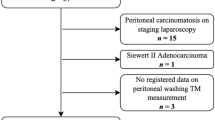Abstract
Purpose
Increased levels of tumor marker in intra-operative peritoneal lavage are associated with an earlier detection of recurrent peritoneal dissemination.
Method
Intra-operative peritoneal lavage samples from 193 patients with gastric cancer were obtained to determine the levels of the tumor markers, carcinoembryonic antigen (CEA) and cancer-related antigen 72-4 (CA72-4) using a chemiluminescent enzyme immunoassay.
Results
The peritoneal lavage CEA (CY-CEA), CA72-4 (CY-CA72-4) and serosal invasion were independent factors predicting the peritoneal dissemination including CY(+). The patients were divided into four groups on the basis of peritoneal lavage tumor marker status; group A: CY-CEA (−), CY-CA72-4 (−) group (CEA < 0.5 ng/ml, CA72-4 < 1.3 U/ml); group B: CY-CEA (−), CY-CA72-4 (+) group (CEA < 0.5 ng/ml, CA72-4 ≥ 1.3 U/ml); group C: CY-CEA (+), CY-CA72-4 (−) group (CEA ≥ 0.5 ng/ml, CA72-4 < 1.3 U/ml); and group D: CY-CEA (+), CY-CA72-4 (+) group (CEA ≥ 0.5 ng/ml, CA72-4 ≥ 1.3 U/ml). The 5-year survival among the patients in groups A, B, C and D was 87, 68, 38 and 20 %, respectively (p < 0.0001).
Conclusion
Combined analysis of these markers is therefore considered to be helpful for accurately determining sites of recurrence and the prognosis in advanced gastric cancer patients.


Similar content being viewed by others
Abbreviations
- CY(+):
-
Peritoneal lavage cytological positive
- CEA:
-
Carcinoembryonic antigen
- CA72-4:
-
Cancer-related antigen 72-4
- CA125:
-
Cancer antigen 125
- CY-CEA:
-
The peritoneal lavage carcinoembryonic antigen
- CY-CA72-4:
-
The peritoneal lavage cancer-related antigen 72-4
References
Asao T, Fukuda T, Yazawa S, Nagamachi Y (1991) Carcinoembryonic antigen levels in peritoneal washings can predict peritoneal recurrence after curative resection of gastric cancer. Cancer 68:44–47
Byrne DJ, Browning MCK, Chschieri A (1990) CA72-4: a new tumor marker for gastric cancer. Br J Surg 77:1010–1013
Emoto S, Ishigami H, Yamashita H, Yamaguchi H, Kaisaki S, Kitayama J (2012) Clinical significance of CA125 and CA72-4 in gastric cancer with peritoneal dissemination. Gastric Cancer 15:154–161
Fayed ST, Ahmad SM, Kassim SK, Khalifa A (1998) The value of CA125 and CA72-4 in management of patients with epithelial ovarian cancer. Dis Markers 14:155–160
Fujimoto T, Zhang B, Minami S, Wang X, Takahashi Y, Mai M (2002) Evaluation of intraoperative intraperitoneal cytology for advanced gastric cancer. Oncology 62:201–208
Hamazoe R, Maeta M, Matsui T, Shibata S, Shiota S, Kaibara N (1992) CA72-4 compared with carcinoembryonic antigen as a tumor marker for gastric cancer. Eur J Cancer 28(8–9):1351–1354
Ikeguchi M, Katano K, Saitou H, Tsujitani S, Maeta M, Kaibara N (1997) Pre-operative serum levels of CA72-4 in patients with gastric adenocarcinoma. Hepatogastroenterol 44:866–871
Kim DH, Oh SJ, Oh CA, Choi MG, Noh JH, Sohn TS et al (2011) The relationships between perioperative CEA, CA19-9, and CA72-4 and recurrence in gastric cancer patients after curative radical gastrectomy. J Surg Oncol 104:585–591
Kiyasu Y, Kaneshima S, Koga S (1981) Morphogenesis of peritoneal metastasis in human gastric cancer. Cancer Res 41:1236–1239
Maehara Y, Sugimachi K, Akagi M, Kakegawa T, Shimazu H, Tomita M (1990) Serum carcinoembryonic antigen level increase correlate with tumor progression in patients with differentiated gastric carcinoma following non-curative resection. Cancer Res 50:3952–3955
Maehara Y, Hasuda S, Koga T, Tokunaga E, Kakeji Y, Sugimachi K (2000) Postoperative outcome and sites of recurrence in patients following curative resection of gastric cancer. Br J Surg 87:353–357
Moore GE, Sako K, Kondo T, Badillo J, Burke E (1961) Assessment of the exfoliation of tumor cells into the body cavities. Surg Gynecol Obstet 112:469–474
Nishiyama M, Takashima I, Tanaka T, Yoshida K, Toge T, Nagata N et al (1995) Carcinoembryonic antigen levels in the peritoneal cavity: useful guide to peritoneal recurrence and prognosis for gastric cancer. World J Surg 19:133–137
Paterson AJ, Schlom J, Sears HF, Bennett J, Colcher D (1986) A radioimmunoassay for the detection of a human tumor-associated glycoprotein (TAG-72) using monoclonal antibody B72-3. Int J Cancer 37:659–666
Rosenberg R, Hoos A, Mueller J, Baier P, Stricker D, Warmer M et al (2002) Prognostic significance of cytokeratin-20 reverse transcriptase polymerase chain reaction in lymph nodes of node-negative colorectal cancer patients. J Clin Oncol 20:1049–1055
Sobin LH, Wittekind CH (1997) International Union Against Cancer: TNM classification of malignant tumors, 5th edn. Wiley, New York
Sougioultzis S, Syrios J, Xynos ID, Bovaretos N, Kosmas C, Sarantonis J et al (2011) Palliative gastrectomy and other factors affecting overall survival in stage IV gastric adenocarcinoma patients receiving chemotherapy: a retrospective analysis. Eur J Surg Oncol 37:312–318
Sugarbeker PH, Yonemura Y (2000) Clinical pathway for the management of resectable gastric cancer with peritoneal seeding: best palliation with a ray of hope of cure. Oncology 58:96–107
Washington K (2010) 7th Edition of the AJCC Cancer staging manual: stomach. Ann Surg Oncol 17:3077–3079
Yamamoto M, Baba H, Kakeji Y, Endo K, Ikeda Y, Toh Y et al (2004) Prognostic significance of tumor markers in peritoneal lavage in advanced gastric cancer. Oncology 67:19–26
Yamamoto M, Taguchi K, Baba H, Endo K, Kohnoe S, Okamura T (2006) The features of peritoneal dissemination with early gastric cancer. Surg Today 36(9):835–838
Yamamoto M, Baba H, Toh Y, Okamura T, Maehara Y (2007) Peritoneal lavage CEA/CA125 is a prognostic factor for gastric cancer patients. J Cancer Res Clin Oncol 133:471–476
Yu W, Whang I, Suh I, Averbach A, Chang D, Sugerbaker PH (1998) Prospective randomized trial of early postoperative intraperitoneal chemotherapy as an adjuvant to resectable gastric cancer. Ann Surg 228:347–354
Conflict of interest
The authors declare no conflicts of interest.
Author information
Authors and Affiliations
Corresponding author
Rights and permissions
About this article
Cite this article
Yamamoto, M., Yoshinaga, K., Matsuyama, A. et al. CEA/CA72-4 levels in peritoneal lavage fluid are predictive factors in patients with gastric carcinoma. J Cancer Res Clin Oncol 140, 607–612 (2014). https://doi.org/10.1007/s00432-014-1601-y
Received:
Accepted:
Published:
Issue Date:
DOI: https://doi.org/10.1007/s00432-014-1601-y




